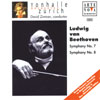Beethoven Symphonies Nos 7 & 8
View record and artist detailsRecord and Artist Details
Composer or Director: Ludwig van Beethoven
Genre:
Orchestral
Label: Classics
Magazine Review Date: 7/1998
Media Format: CD or Download
Media Runtime: 61
Mastering:
Stereo
DDD
Catalogue Number: 74321 56341-2

Tracks:
| Composition | Artist Credit |
|---|---|
| Symphony No. 7 |
Ludwig van Beethoven, Composer
David Zinman, Conductor Ludwig van Beethoven, Composer Zurich Tonhalle Orchestra |
| Symphony No. 8 |
Ludwig van Beethoven, Composer
David Zinman, Conductor Ludwig van Beethoven, Composer Zurich Tonhalle Orchestra |
Author:
No one who relates to Toscanini’s Beethoven on the one hand or Gardiner’s on the other will take issue with David Zinman’s ‘short ride in a fast machine’ approach to the Eighth Symphony (with apologies to John Adams). Zinman’s record is billed as the “world premiere recording on modern instruments according to the new Barenreiter Edition” and, like its predecessor (Symphonies Nos. 5 and 6, 12/97), packs a fair punch.
The Eighth, I have to say, is exhilarating in the extreme. Every strand of argument bristles with life, especially among the first movement’s centre pages, while in the finale, even the ludicrously fast metronome marking (minim=80) finds the Tonhalle players keeping up the pace. Try 2'01'' into track 8, where timpani and bassoon race ahead like members of a crack dance band, or the Menuet’s Trio (2'05'' into track 7), played properly in tempo and with a solo cello taking the accompanying lead. Horns and clarinets excel throughout and while not appropriate to every mood (Knappertsbusch on Tahra provides an affecting point of contrast) Zinman’s view of the Eighth makes for essential listening.
His Seventh is slightly more problematic in that while similar virtues pertain, a certain levelling of dynamics does rather compromise important dramatic episodes, such as the thrilling flight to fortissimo 3'58'' into the first movement, one bar before fig. B. On the other hand, we hear many new things: prominent violas at 2'43'' (secondary string lines are admirably clear throughout both performances); accents on the first beat of the bar at 4'40'' (from bar 124); an unfamiliar trilling bassoon at 8'09'' and an extended oboe cadenza at 10'18'' that reminds us of the parallel passage in the first movement of the Fifth Symphony (which, in Zinman’s recording, is extended even further). There are embellishments to the woodwind line 6'04'' into the Allegretto and when it comes to the final bars of the same movement, strings play pizzicato rather than the more familiararco.
Horns ring out in the Scherzo’s Trio (played very fast and with minimal vibrato from the strings) and the swirling finale, which is performed with tremendous dynamism, suggests disco-style momentum: Wagner’s epithet of an “apotheosis of the dance” has rarely been more apt in contemporary terms. All repeats are played in both symphonies; the recordings are excellent and I would say that if your current library preference is for one of the modern-instrument ‘greats’, Zinman at super-budget price will prove both instructive and refreshing. No appropriate comparison offers the same coupling, so I would happily recommend an impulse purchase. Annotation is excellent, with informed and absorbing coverage of the Barenreiter edition from Jonathan Del Mar.'
The Eighth, I have to say, is exhilarating in the extreme. Every strand of argument bristles with life, especially among the first movement’s centre pages, while in the finale, even the ludicrously fast metronome marking (minim=80) finds the Tonhalle players keeping up the pace. Try 2'01'' into track 8, where timpani and bassoon race ahead like members of a crack dance band, or the Menuet’s Trio (2'05'' into track 7), played properly in tempo and with a solo cello taking the accompanying lead. Horns and clarinets excel throughout and while not appropriate to every mood (Knappertsbusch on Tahra provides an affecting point of contrast) Zinman’s view of the Eighth makes for essential listening.
His Seventh is slightly more problematic in that while similar virtues pertain, a certain levelling of dynamics does rather compromise important dramatic episodes, such as the thrilling flight to fortissimo 3'58'' into the first movement, one bar before fig. B. On the other hand, we hear many new things: prominent violas at 2'43'' (secondary string lines are admirably clear throughout both performances); accents on the first beat of the bar at 4'40'' (from bar 124); an unfamiliar trilling bassoon at 8'09'' and an extended oboe cadenza at 10'18'' that reminds us of the parallel passage in the first movement of the Fifth Symphony (which, in Zinman’s recording, is extended even further). There are embellishments to the woodwind line 6'04'' into the Allegretto and when it comes to the final bars of the same movement, strings play pizzicato rather than the more familiar
Horns ring out in the Scherzo’s Trio (played very fast and with minimal vibrato from the strings) and the swirling finale, which is performed with tremendous dynamism, suggests disco-style momentum: Wagner’s epithet of an “apotheosis of the dance” has rarely been more apt in contemporary terms. All repeats are played in both symphonies; the recordings are excellent and I would say that if your current library preference is for one of the modern-instrument ‘greats’, Zinman at super-budget price will prove both instructive and refreshing. No appropriate comparison offers the same coupling, so I would happily recommend an impulse purchase. Annotation is excellent, with informed and absorbing coverage of the Barenreiter edition from Jonathan Del Mar.'
Discover the world's largest classical music catalogue with Presto Music.

Gramophone Digital Club
- Digital Edition
- Digital Archive
- Reviews Database
- Full website access
From £8.75 / month
Subscribe
Gramophone Full Club
- Print Edition
- Digital Edition
- Digital Archive
- Reviews Database
- Full website access
From £11.00 / month
Subscribe
If you are a library, university or other organisation that would be interested in an institutional subscription to Gramophone please click here for further information.




